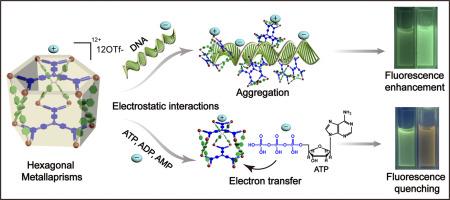用于生物分子传感的基于四苯乙烯的巨型六方发射金属
IF 6.3
3区 综合性期刊
Q1 Multidisciplinary
引用次数: 0
摘要
巨型发射金属材料的开发不仅是一项合成挑战,而且对其应用具有重要意义。在此,我们报道了一种直径达3.7 nm的四苯基乙烯(TPE)发射六方金属棱镜,这是最大的TPE基金属棱镜之一。它们可以通过不同模式的静电相互作用与聚合物和小分子相互作用。它们与DNA形成密集的聚集,这将抑制分子运动并提供增强的发射。然而,光诱导电子从核苷酸到金属棱镜的转移发生在络合后,因此它们显示出ATP和ADP的发射减少。该研究提供了一种用于选择性生物传感的巨发射金属棱镜,对未来生物应用金属材料的设计具有指导意义。本文章由计算机程序翻译,如有差异,请以英文原文为准。

Tetraphenylethylene-based giant emissive hexagonal metallaprisms for biomolecule sensing
The development of giant emissive metallacages is not only a synthetic challenge but also important for their applications. Herein, we report a type of tetraphenylethylene (TPE)-based emissive hexagonal metallaprism with diameters as large as 3.7 nm, which represents one of the largest TPE-based metallacages. They can interact with polymers and small molecules via electrostatic interactions in different modes. They form dense aggregations with DNA, which would inhibit the molecular motions and offer enhanced emission. However, photoinduced electron transfer from nucleotides to metallaprisms occurs after complexation, so they show decreased emission for ATP and ADP. This study provides a type of giant emissive metallaprism for selective biosensing, which will guide the future design of metallacages for bio-applications.
求助全文
通过发布文献求助,成功后即可免费获取论文全文。
去求助
来源期刊

Fundamental Research
Multidisciplinary-Multidisciplinary
CiteScore
4.00
自引率
1.60%
发文量
294
审稿时长
79 days
期刊介绍:
 求助内容:
求助内容: 应助结果提醒方式:
应助结果提醒方式:


